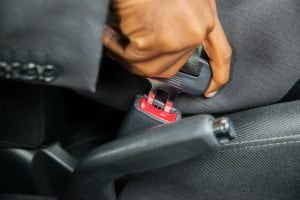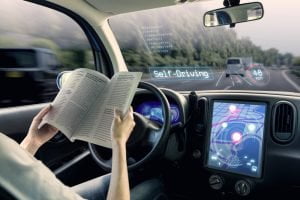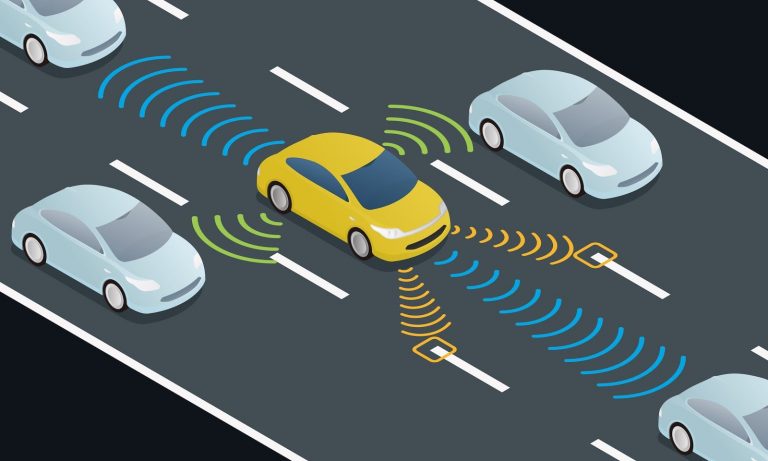No Driving Required: What Automated Vehicles (Driverless Cars) Mean for Our Future

John Hawthorne is a new writer for The Car Guy. What follows are opinions from John on the future of driverless cars. I’ve got my own opinion on this matter. If users of cars in our immediate future don’t want to drive themselves to a location, or they’d rather do the journey without the responsibility of actually driving a car, there are a number of methods that they can choose. Of course, the first that exists today is something called a taxi – remember them?
Typically, you use your smartphone to call a taxi and upon its arrival, you ‘autonomously drive’ to the destination. The taxi operator does the driving, but in your situation, you don’t have to negotiate the actual car, nor the traffic lights, traffic, speed, braking or any other part of driving. You just become a passenger and you pay their meter fare.
The same applies to ride shares such as Uber and Lyft. You don’t need to buy a car. You ask for a ride-share car on your phone’s app – it arrives and autonomously you’re ferried to your destination. Typically the company direct charges your credit card – simples!
And of course there are buses, ferries, trains, and planes – you don’t need to do anything other than walk to the device.
And what about the cost? Certainly, the early adopters will want an autonomous car because they can. The same was true with the early electric cars. I know of only 2 of my customers who own and are using pure electric and they’re both driving Tesla Model S – around $150,000. There’s no doubt that fully autonomous cars will attract a substantial premium, at least in the first few years of their existence. As the technology improves and becomes commercially available, the volume priced manufacturers will be able to invest in them. Then there’ll be the choice – petrol, diesel, electric, hydrogen-powered cars – autonomous or self-driving.
What a future we will have
“Like many, you may have spent this morning sitting in an hour of bumper-to-bumper traffic, impatiently tapping your steering wheel as you inched ever so slowly toward your office.
This is the norm for millions of people around the world, but all that looks like it will be changing, and sooner than you might think.
Autonomous vehicles (AV) are The Next Big Thing in the tech industry. It might sound a little like a farfetched science fiction movie but think back to those landline locked days when phones were used merely for necessary communication. Who could have envisioned a world in which we all hold the internet in our hands?
Yet in 10 years that has become our reality, and it looks as if the same will be true for driverless cars. Google, Uber, and Tesla – to name a few – are already developing and testing prototypes and some autonomous features are currently available in certain cars.
So what does this new world of driving mean for us? That’s the big question, and it’s not so easily answered. However, what we do know points to some pretty exciting things as this technology revolutionizes the way we all travel.
What Does It Mean for Safety?

One of the greatest pushes for autonomous vehicles is the obvious improvements in safety that would result. In 2016, the United States alone saw over 31,000 fatal car accidents, resulting in over 35,000 deaths, most of these attributed to human error. Take the human out of the equation and you have a possible solution to this problem.
This increased safety is pretty much guaranteed. The automated vehicles will have the internal technology to “talk,” not just to us, but to roads, other vehicles, and even traffic signals. The sole job of the driverless vehicle will be to safely deposit its passengers at their destination.
Think of all the risks drivers currently face:
- Distraction of mobile devices
- Road rage
- Drowsiness/sleepiness behind the wheel
- Driving under the influence of alcohol or drugs
- Attending to children’s needs while driving
- Running late and rushing
The list goes on and on – drivers are at risk primarily because human beings are flawed, and even the best driver can have a bad day. Driverless vehicles take these risk factors out of our transportation experience.
However, there are some who would argue that there are inherent risks in the development of this kind of advanced technology. As with much modern day technology, there is potential for cybercriminal activity and hacking.
The Wall Street Journal, in an article entitled “The Dangers of the Hackable Car,” reports that, “Some experts warn of a day when millions of fully internet-connected vehicles will be at risk of being hijacked remotely. A mass hack could be catastrophic for the self-driving cars of the future, especially if those cars don’t have steering wheels or other backup systems to let drivers take manual control.”
In spite of these concerns, most agree that the improvements in the overall safety of human beings far outweigh the possible risks that might follow, especially considering that most of these companies are already doing the research and development necessary to guard against such dangers.
What Does It Mean for Productivity

In the new world of autonomous vehicles, not only are people safer, they are able to make more productive use of the time. All those distractions we just mentioned that put drivers at risk? They disappear.
- Your phone no longer distracts you from the task at hand, but rather IS the task at hand, as you allow the vehicle to take you where you want to go.
- Didn’t get enough sleep? Catch up with a nap on your commute to work.
- A few drinks don’t mean danger to you or anyone around you as you get into your car.
- Conference calls and meetings can simply happen on the way to and from work, and not just when you are in the office.
The possibilities are endless. Rather than spend hours of your life driving to and from destinations, you are now able to accomplish more than ever as you let your car do the work for you.
With the average American spending the equivalent of seven 40 hour workweeks in the car each year, this has staggering implications for the way we live.
What Does It Mean for the Economy?

This is one of the main factors which could slow down the progress of this research and development. We know that ultimately, driverless cars have the potential to be very good for the economy. Here are a few ways this technological advance will impact the economy.
As man-driven vehicles become a thing of the past, and so will the jobs entailed by those vehicles. Delivery services, taxi and bus drivers, and truck drivers, to name a few, will become obsolete as those services become automated.
- However, as the need for these jobs gradually decreases, there will be in an influx of new jobs as well, as a result of this technology. This will likely happen over time, meaning a gradual job displacement, rather than rapid, mass job loss.
- While it’s hard to know exactly how the public would respond as automated vehicles become the primary means of transportation, car ownership may drastically decrease, and investment in a vehicle will become an outdated concept. After all, many already choose to grab an Uber over driving for themselves. Why purchase an automated vehicle when you can just rent one for your commute every day?
- We could see growth in cities as massive parking garages are no longer needed, and that space becomes available for homes, businesses, or even green space.
The economic implications of the driverless car seem complex and ffar-reaching but it’s important to recognize that these changes will be happening incrementally, and much of what’s predicted will be a long time in the making.
What Does It Mean For the Environment?
This is a pretty open-ended question, with very little certainty about the answer. For now, it seems that autonomous vehicles have the potential to be either great, or really not great, for the environment. Here are some of the potential positive impacts:
- The decrease in safety risk means a decrease in safety precautions. Much of the current equipment required for vehicle safety will not longer be needed, meaning less energy spent developing those materials, and less weight in the vehicle itself, resulting in less energy required for the vehicle to run.
- Programming might mean that cars only ever use the most fuel-efficient routes.
- Automated vehicles could use up to 90% less energy than cars today.
What are the potential negative impacts, though?
- Because car rides would no longer require anything of the driver, many might be willing to live even farther from the workplace, or more readily take long drives, as it won’t negatively impact the time in their day, meaning MORE driving, not less.
- See that last point in the positive impacts column? Well, it’s true that automated vehicles could use up to 90% less energy, but it’s also true that they could use up to 200% more, according to researchers.
It’s hard for even the experts to really know how the advent of automated driving will impact our environment, but researchers and developers building these prototypes are listening to concerns and being very proactive as they look to the future of driving.
What Does it Mean for the Car Itself?
When you imagine this driverless car taking you where you need to go, you’re probably picturing your current vehicle without a steering wheel, or something along those lines. However, in actuality, cars may be entirely redesigned as steering and powering features become automated and certain safety features are no longer necessary.
You might see:
- Chairs that swivel so that occupants can face one another and chat or conduct meetings (as with the Mercedes Benz F015)
- Interiors designed specifically tailored for the desires of the owner.
- Sofas or beds for lounging and relaxing.
The car’s place in society will change as well. If car ownership becomes a thing of the past, so will the idea of garages, not just parking garages, but home garages as well. Thus the change in car design could lead to a change in home design.
As transportation changes, so will people’s lives, and this has far-reaching implications for the makeup of our not just our homes, but our cities, and ultimately the world, as well.
Automated Vehicles are Coming: Are You Ready?

While it’s true that the road to driverless cars is a long one, there’s no doubt that we are already driving down that road (or being driven down that road, as the case may be).
While some might view this prospect as somewhat frightening, it has the potential to improve all of our lives for the better, giving us hours back in our day and making us, and those who come after us, safer than ever as we travel from place to place.
This article originally appeared here at http://www.muziford.com/blog/2017/september/27/no-driving-required-what-automated-vehicles-mean-for-our-future.htm and has been reproduced with permission from muzichevyma.com
 Bob Aldons is the owner and founder of The Car Guy, reviewing cars, reporting on car industry matters, car tech and the world at large.
Bob Aldons is the owner and founder of The Car Guy, reviewing cars, reporting on car industry matters, car tech and the world at large.
Find One
If you’re hunting around for a great price on your next new car, you should call the auto expert, Bob Aldons from Car Business. My company, a car Broker, Car Buyers Agent or Car Buyers Advocate based on the north side of Brisbane, will return your inquiry within 24 hours and make the process of buying a new car easy and stress-free. Are you tired of salesperson tricks? I protect you from the pressure exerted by car dealer’s salespeople. There isn’t any obligation – just a pretty significant saving.
You’re where? Seriously, my services are available for you in any Australian state and territory: from Darwin to Hobart, Cairns to Perth. Car Broker Brisbane, Sydney, Melbourne, Adelaide, Perth, Hobart, and Darwin – I’m available when you need me to be.
Here’s an example
Matt wanted to purchase a Mazda 3 SP25 GT Manual Hatch. The retail value, drive away on that car is around $35,000. Car Business managed to purchase the same car for $28, 123.90 and with our fee Matt paid $25, 588, a saving of over $6000. And how do we know? Another customer, (looking for a new Holden HSV) just paid $35,000 for the same car – but he did it himself, without our assistance
If you’ve got a vehicle to trade, we have some clever ways to maximize the value – from used car dealers keen for your car to assist you to sell it privately. Finance and Insurance? We can handle that too, and we promise you will not be paying exorbitant dealer markups there either.
Trade In Value Example
2014 Jeep Cherokee Limited. Average dealer trade value – $16500. We achieved $22,000
2014 Volkswagen Tiguan 118TSI. Average dealer trade value – $14000. We achieved $16000
So, to get the best new car price, talk to others and then talk me. I’ve got the experience to handle the dealers and achieve the lowest new car prices. If you think you’re entitled to fleet pricing, I can often get better than that too. Whether you’re a small fleet or a large national fleet, Car Business will go to work and get that price down. Lower new car prices are my goal. So you’ll get the best prices from us rather than hoping you can help yourself.
If I can’t get you the best new car price, better than you can get yourself from a car dealer, we won’t charge you any fee. No Saving, No Fee. – that’s what you should expect from a car buying expert.
Car Business WILL save you money on your next new car purchase – guaranteed
